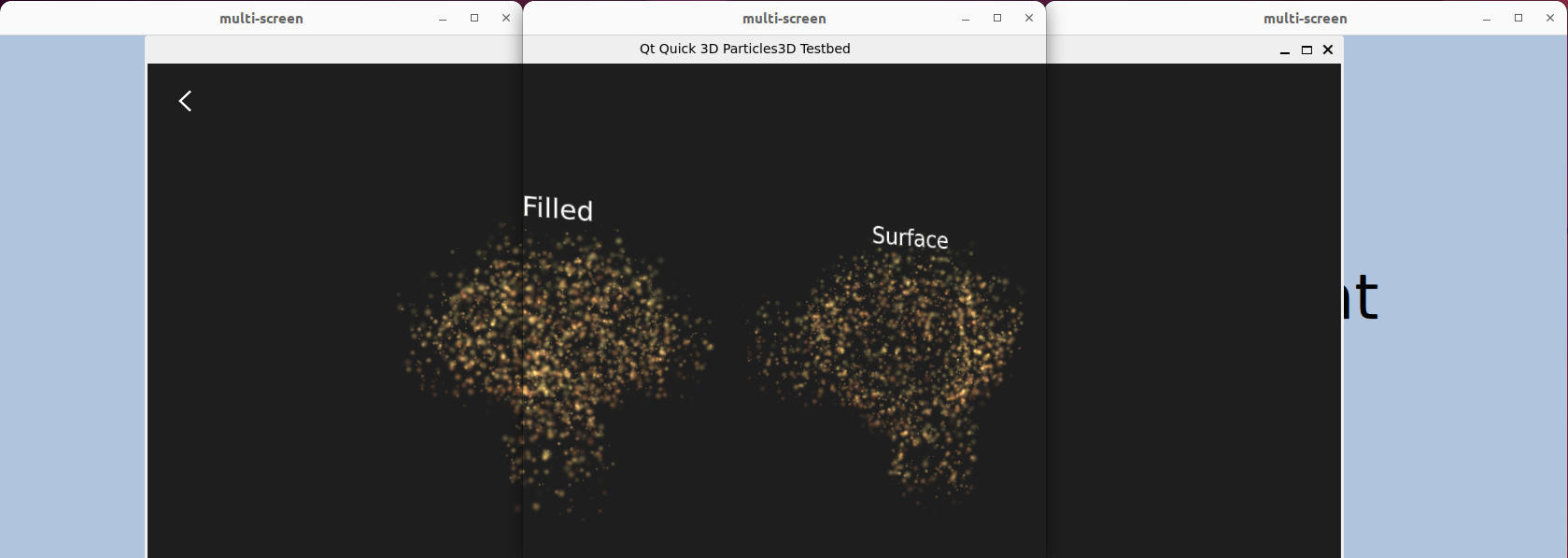多屏幕
Multi Screen 是一款桌面风格的 Wayland 多屏合成器。
简介
Multi screen 是一个桌面风格的 Wayland 多屏合成器示例。

有关使用 Qt 创建多屏幕合成器的基本原理介绍,请参阅 Minimal QML。 Qt Wayland Compositor的基本原理,请参阅Minimal QML 示例。
支持多屏幕
对于系统上的每个可用屏幕,该示例都会创建一个CompositorScreen ,它是WaylandOutput 的子类。如果只有一个可用的物理屏幕,该示例会用假数据模拟三个屏幕。
Instantiator { id: screens model: emulated ? emulatedScreens : Qt.application.screens delegate: CompositorScreen { surfaceArea.color: "lightsteelblue" text: name compositor: comp screen: emulated ? Qt.application.screens[0] : modelData Component.onCompleted: if (!comp.defaultOutput) comp.defaultOutput = this position: Qt.point(virtualX, virtualY) windowed: emulated } }
每个WaylandOutput 都包含一个Window 窗口,用于包含客户端内容,标准设置为 Qt Wayland Compositor.由于每个窗口都与其他窗口隔离,我们无法在它们之间共享任何Qt Quick 项目。因此,当客户端连接并创建ShellSurface 时,每个屏幕上都会创建一个ShellSurfaceItem 。
for (var i = 0; i < screens.count; ++i) createShellSurfaceItem(shellSurface, moveItem, screens.objectAt(i));
这些项目作为同一客户端内容的视图。客户端界面本身只创建一次,并由界面项共享。
顶层表面项作为背景Rectangle 的子项创建在每个输出中。这些视图将保存起来以备日后使用,如果客户端生成了任何子窗口,这些子窗口将作为顶层窗口项的父级窗口。
var parentSurfaceItem = output.viewsBySurface[shellSurface.parentSurface]; var parent = parentSurfaceItem || output.surfaceArea;
ShellSurfaceItem 的位置是同步的,因此当窗口进入一个屏幕时,它们会同时从另一个屏幕移出。这样就会呈现出单个项目在不同屏幕间无缝移动的效果。客户端的全局位置存储在共享的moveItem 中,每个屏幕上ShellSurfaceItem 的相对位置都是据此计算的。如果moveItem 当前超出了某个屏幕的范围,其坐标将反映出这一点,并且在该屏幕上将不可见。
x: surfaceItem.moveItem.x - surfaceItem.output.geometry.x y: surfaceItem.moveItem.y - surfaceItem.output.geometry.y
最后,WaylandQuickItem::setPrimary() 会在适当的时候被调用,以设置ShellSurface 的主视图,在客户端要求最大化或全屏时使用。ShellSurfaceItem 的主视图是根据当前可视面积来选择的。
注: 为了在同一合成器中支持多个 Wayland 输出,必须在构建QGuiApplication 对象之前设置Qt::AA_ShareOpenGLContexts 属性。在示例中,我们在main() 函数的开头设置了该属性。
QCoreApplication::setAttribute(Qt::AA_ShareOpenGLContexts, true);
另请参阅 多重输出。
© 2025 The Qt Company Ltd. Documentation contributions included herein are the copyrights of their respective owners. The documentation provided herein is licensed under the terms of the GNU Free Documentation License version 1.3 as published by the Free Software Foundation. Qt and respective logos are trademarks of The Qt Company Ltd. in Finland and/or other countries worldwide. All other trademarks are property of their respective owners.

